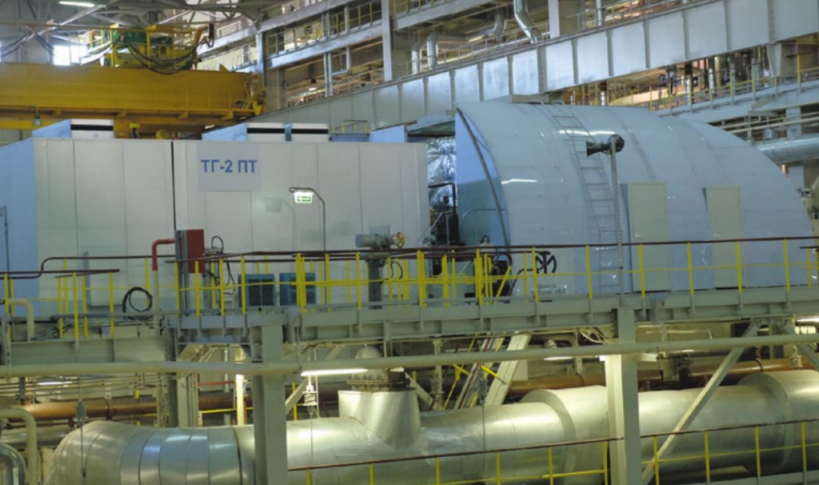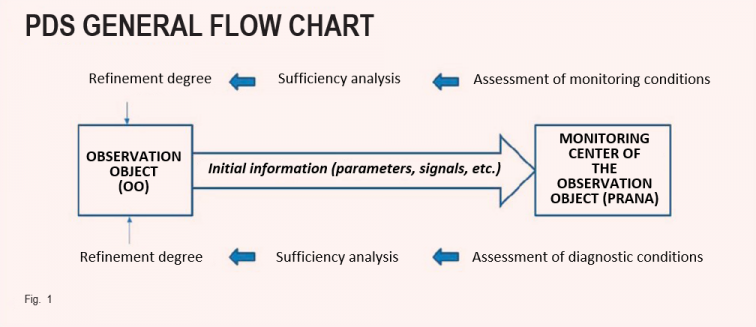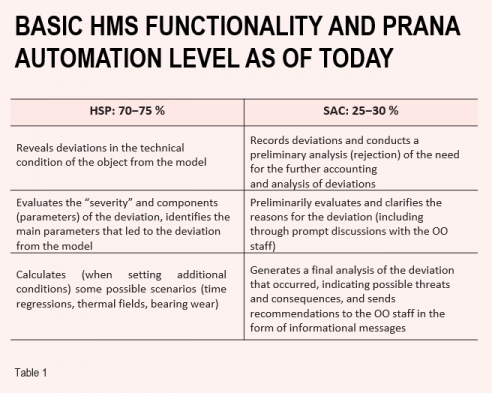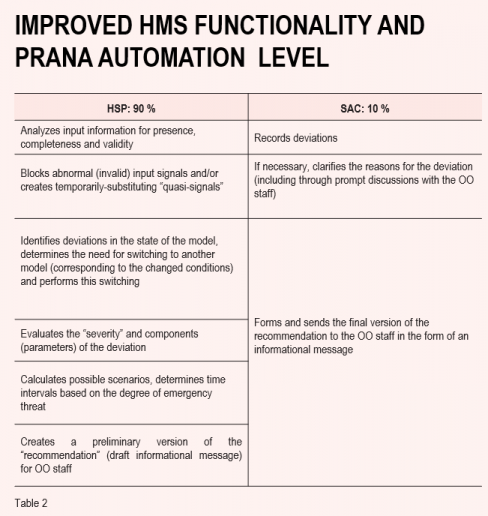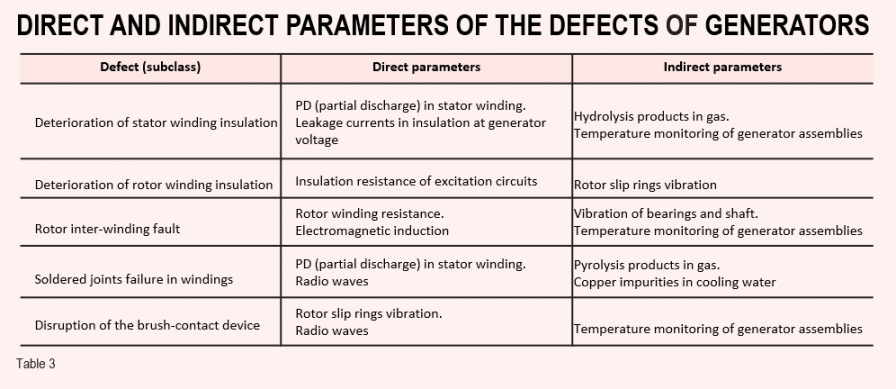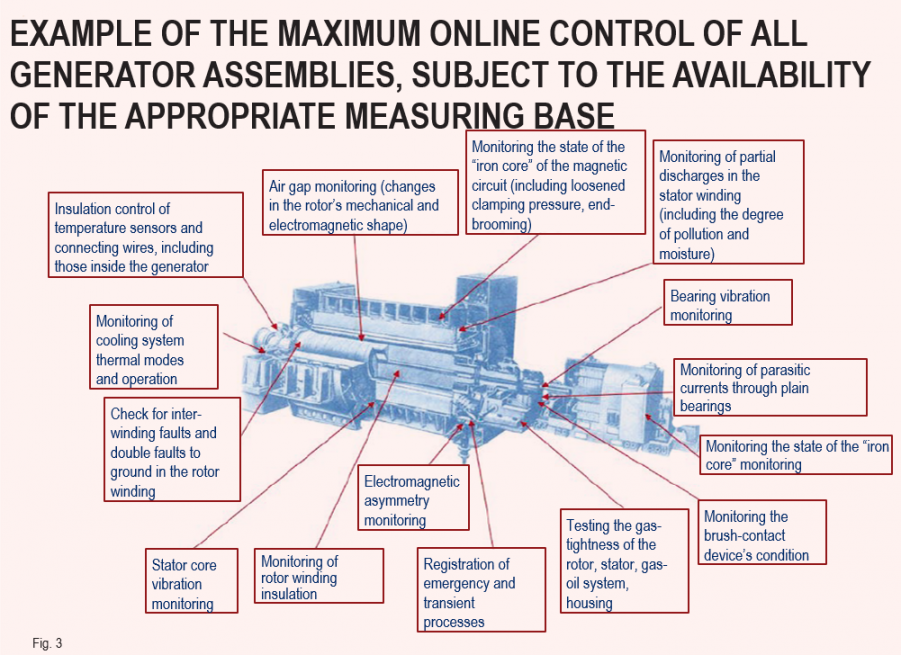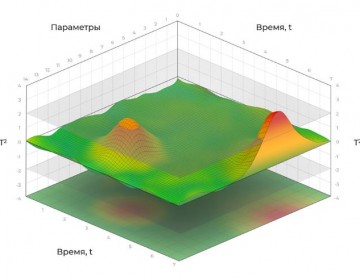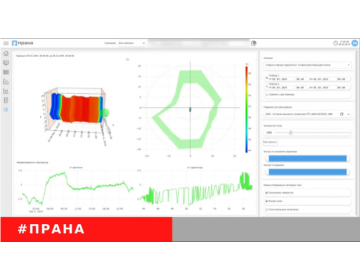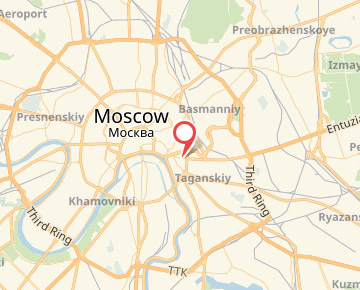DIAGNOSTICS OF HIGH-VOLTAGE ROTATING ELECTRICAL EQUIPMENT USING THE EXAMPLE OF A GENERATOR. PRANA SYSTEM FOR GENERATORS
Monitoring-and-diagnostics data (M&D) form the basis for determining the technical condition of high-voltage equipment and developing repair schedules for such equipment. World experience shows that from the economic standpoint, it is expedient to carry out such monitoring using the remote online monitoring of facilities. In this case, all generator assemblies can be monitored online. At present, the corresponding measuring base has been created for each component of a modern generator, which makes it possible to equip generators with sensors and systems for monitoring and diagnostics in any variation and package (in terms of control).
AUTHOR: O. A. ZAKHAROV, ROTEC JSC
INTRODUCTION
The main focus of the development and application of technical diagnostics and monitoring methods in relation to energy facilities is to reduce (eliminate) the most frequently-occurring damage to equipment, as well as damage associated with a significant undersupply of electricity. But, as demonstrated by the world’s [1, 2] and Russia’s experience [3, 4], the existing automated process control systems (APCS) at energy facilities cannot provide a complete scope of diagnostics of the elements and assemblies of installations: they identify defects in an untimely manner, use under-sensitive diagnostic methods and are incapable of predicting technical condition.
The shortcomings and limitations of existing APCS systems, as well as the development of computer technology, data-processing methods and machine-learning algorithms, have formed the main vectors for the advancement of monitoring and diagnostics:
- online monitoring and diagnostics system – the creation and practical implementation of an interconnected complex of analytical actions based on the continuous monitoring and diagnostics of the technical parameters of the object of interest;
- database processing system – the ability to handle data volumes of any size arriving from a facility, to implement any variety of applied content, including for the end user;
- situational center of experts in specialized areas – occupational distribution of human resources in terms of expert analytics for specific types of equipment, regardless of the geographical distribution of facilities;
- integrated measurement system — merging the functionality of the following elements into a single complex:
- physical measurement sensors,
- channels for transmitting these measurements to a higher level,
- means of converting physical measurements into a “digit”,
- mathematical tool for converting a “digit” into visual reporting information for users at various levels.
Each of these areas finds practical development at ROTEC JSC within the implementation scope of the PRANA system – an automated information system for the continuous remote monitoring and forecasting of the technical condition of industrial equipment, designed to improve work efficiency and reduce operating costs by switching from WEP (work execution planning) to condition monitored repairs. The system automatically collects and processes data from the standard measuring equipment of the control and monitoring system in real time, carrying out complex unit-by-unit diagnostics based on one of the variations of the similarity method, analyzing the thermal and vibration changes in the monitored parameters. The process of system functioning includes expert assessments of the permissibility of further operation as well as recommendations for maintenance and repair. (See [5] for details about the PRANA system and its methods.)
In 2016–2020, work was carried out to connect to PRANA and provide services for the remote monitoring of energy facilities. This made it possible to clarify the scope of tasks in the implementation of diagnostic and remote monitoring systems. In particular, as experience with the monitoring and diagnostics of all power equipment has shown, the quality and optimality of further maintenance through the implemented PRANA remote monitoring and diagnostics system (RMDS) directly depends on the pre-design survey (PDS) of the observation object (OO). The parameters characterizing the automation of the monitoring and diagnostics process, the scope of indirect indications for identifying a specific defect, and the issues associated with the insufficient supply of control devices for some equipment have all been determined.
PROCESS OF PRE-DESIGN SURVEY AND ITS PRACTICAL RESULTS
General view of PDS is shown in Fig. 1.
PDS is simultaneously conducted in two directions and aspects of subsequent maintenance:
1) monitoring, during which the available archived data of parameter arrays are assessed by volume and type (amount and type of analog and discrete signals), by retrospective depth (what time period was recorded with an acceptable sampling rate and for what parameter array), by signal transmission discretization;
2) diagnostics, involving the evaluation of data on the features of operation, operating mode, scheduling of repairs, availability and/or delivery times of spare parts (components), and information on accidents for the previous period (optimally, for 3−5 years).
PRANA specialists, analyzing this information and taking into account the additional wishes of the OO owner (in the form of a technical assignment), form the final draft of the OO refinement for the required monitoring horizon and optimal level of equipment with diagnostic tools and systems (in the form of technical solutions).
Refinement is always present, since PRANA requires a specially-formed upper-level ACS for OO placed on the owner’s server. In addition, it is necessary to create a data-transmission channel from the OO to PRANA that meets the following mandatory conditions: protection from outside interference and the prohibition of any impact on the OO from PRANA. This is the so-called basic refinement.
For the majority of OOs, a significant rework is required, including both the installation of additional sensors and monitoring and diagnostic systems, as well as the integration of information on the owner’s servers at the output from OO (ahead of the upper-level ACS).
CREATION OF A DIGITIZED OBSERVATION OBJECT
Figure 2 illustrates the transformation of the primary OO into a digitized object as a result of the implementation of technical solutions and the work of the copyright-holder’s corporate specialists. It is the digitized OO that is the desired end product, on whose basis PRANA evaluates the technical condition of the OO and issues recommendations for further operation.
The blocks “PDS” and “Refinement” are mentioned above and are clear. Explanation is required for the blocks “Models” and “HSP” (software and hardware package).
The “Models” block implies the process of forming reference arrays of parameters (databases, DB) for monitoring the OO for each of the characteristic modes of operation, both steady-state (at different loads) and transient (shutdown, run-down, startup). At the same time, one should take into account the fact that the array’s being a reference does not depend on the initial state of the OO, since at any time and at any phase of operation, a conditionally-acceptable slice of DB can be found, which will be the starting point for assessing a change in the technical condition of the OO for the worse (degradation).
“PAC” block is a mathematical apparatus that uses multidimensional vector statistical models, where a method based on Hotelling's T2 control-chart ideology is used to create a reference model.
PRANA IS A HUMAN-MACHINE SYSTEM
PRANA is a classic human-machine system (HMS), consisting of HSP and technical specialists in modeling, operational dispatch monitoring and expert assessment (SAC). For the assessment and development dynamics of PRANA automation, it is proposed to introduce HSP/SAC ratio metrics. Table 1 characterizes the basic HMS functionality and the level of PRANA automation as of today. The assessment is based on the opinion of experts who use the PRANA system to monitor equipment.
One of the development objectives of PRANA is raising the level of automatization. Based on the experience gained, basic measures have been identified that will allow for substantial automation improvement:
- improvement of the quality and completeness of the primary information transmitted from the object in the process of monitoring the technical condition of the units;
- minimization of “bad signals” from the object upon their appearance due to filtering and temporary substitution with “quasi signals”;
- switch to a fully automated process of changing the models when the operating mode of each unit is changed with the aid of “marker parameters”;
- creation of libraries of correlation parameters and additional calculation algorithms when direct measurements are impossible.
The implementation of these tasks primarily includes finding the solutions for preprocessing data using statistics and machine-learning methods. In case of their unreliability, they are temporarily excluded from the monitoring and forecasting system. On the basis of the accumulated statistics of deviations in the technical condition of the object, the experts of the PRANA project formed distinctive signs of the unreliability of signals, in contrast to cases where the behavior of the parameter value characterizes the actual development of degradations in the technical condition of the object. Work on the automation of expert knowledge is expected to be completed in 2021. According to preliminary estimates, improvement of the PRANA system will lead to an increase in the level of HMS automation by 15–20 % (Table 2).
DIRECT AND INDIRECT PARAMETERS DURING DIAGNOSTICS OF GENERATORS
Now that the necessary explanations on the PRANA methods have been provided, let us proceed directly to the applied topic of our article – the diagnostics of generators. At present, 28 turbine generators are connected to PRANA. Generally speaking, these are generators of the TF-50, TF-63, TF-80, TZFP-160, TZFG-180, 50WY21Z-095 type.
As was noted above, most OO require substantial rework in the process of the preparation of “digitized OO.” For generators, this percentage can be as high as 90 %. Without significant improvements, most effectively and correctly diagnosed is the status of the cooling system and plain bearings. For the remaining assemblies, it is necessary to implement additional approaches associated with both physical modeling and machine learning, as we are logically switching to the need to divide the monitoring and diagnostics parameters of OO into:
- direct, that is, directly dependent on certain defects and clearly indicating the “hotspots” of emergent and/or already progressing degradations;
- indirect, that is, requiring the creation of additional assessment methods and algorithms, as well as taking into account the correlating factors according to the available parameters.
Diagnostics of electromagnetic and electrodynamic defects is of great interest. Since these defects essentially go uncaptured by online monitoring, a link to indirect parameters is necessary. There are already a number of similar solutions using both physical modeling [6] and statistical approaches [7], which gives confidence in the possibility of implementing defect diagnostics based on indirect parameters.
Table 3 shows the relationship between the direct and indirect parameters of the main defects ("electromagnetic" category) of generators.
CURRENT PROBLEMS OF DIAGNOSING GENERATORS
In summary, we can say that, having data on the temperature monitoring and vibration of bearings and creating the necessary software “product,” it is possible to very accurately determine changes in all units of the generator.
It is clear that the use of this approach is a forced measure, which is designed to neutralize the shortcomings of the existing situation with the equipment of generators operating in Russia with instruments and controls.
In fact, all generator assemblies can be monitored online, as shown in Fig. 3. At the same time, in world practice, for each of the components, a corresponding measuring base has been created, which makes it possible to equip the generators with sensors and monitoring and diagnostic systems in any variation and configuration (in terms of control).
In practice, when equipping generators , we must take into account two essential restrictions:
1) need for import substitution;
2) OO integrity violation with significant rework and, respectively, additional costs for the design, installation and subsequent operation of the “Diagnostic circuitry” system.
CONCLUSION
The results of the first five years of implementing projects involving the remote monitoring and forecasting of the condition of generators have allowed for the practical identification of further approaches to developing the PRANA project in the area of generators and for the generation of the following target functions in the near future.
1. Cooperating and stimulating the development of the domestic base of tools and systems for the monitoring and diagnostics of generators.
The approximate technical requirements for these tools and systems are:
- autonomy (energy- independence) for a period of at least one year;
- built-in system of operability self-diagnostics as a whole and element by element, generating sound and light signals at the computer workstations (WKS) of operational and technical personnel;
- diminutiveness and possibility of attachment to any point of an aggregate without structural interventions or other changes in the integrity of the aggregate’s housing and assemblies;
- wireless transmission of the values of measured parameters at the WKS of operational and technical personnel.
2. Improvement of systems like BIG DATA, including for the use of available indirect parameters in full.
The following main basic measures are proposed, allowing for a significant improvement in automation:
- improving the forecasting accuracy of mathematical models through the implementation of intelligent data filtering systems, including using the experience of experts in diagnosing unreliable signals;
- integration into the PRANA system of additional tools, implementing physical modeling and machine-learning methods, for the purposes of diagnosing defects based on indirect parameters.
3. Inclusion, at the manufacturing stage, in the technical specifications for the manufacture and supply of generators, an obligatory condition mandating equipping with the necessary monitoring and diagnostic tools.
Implementation of these tasks, organization of remote monitoring and forecasting centers according to the PRANA principle will allow for the clear, prompt and objective evaluation of the technical condition of generator equipment, both on the whole and for each individual assembly, with the issuance of the corresponding recommendations to administrative and technical personnel for the further operation of generating facilities.
BIBLIOGRAPHY
| 1. | Bembe J.R. Management of condition monitoring and diagnostic technology to optimize large turbo-generator rotor maintenance. PhD thesis. Johannesburg: University of Johannesburg, 2013. |
| 2. | Balasubramanian A., Ranganath Muthhu. Model Based Fault Detection and Diagnosis of Doubly Fed Induction Generators — A Review//Energy Procedia. 2017. Vol. 117. P. 935–942. |
| 3. | Belyakov V.V., Binko G.F., Vinitsky Yu.D. et al. Prospects for digitalization of the control of current technical condition and development of methods for the predictive diagnostics of turbine generators at power plants // Materials of the conference RNC CIGRE, 2019. URL: http://www.cigre.ru/activity/conference/a1/papers/ |
| 4. | Kuznetsov D.V., Polyakov F.A., Sokur P.V. Topical issues of developing methods for the online monitoring and diagnostics of turbine generators when solving problems of increasing reliability and extending service life // Materials of the conference RNC CIGRE, 2019. URL: http://www.cigre.ru/activity/conference/a1/papers/ |
| 5. | Web resource: https://prana-system.com/ |
| 6. | Jichao Hanab, Ping Zheng. Numerical analysis of end part temperature in the turbogenerator end region with magnetic shield structure under different operating conditions//International Journal of Thermal Sciences. 2018. Vol. 132. P. 267–274. |
| 7. | Pak KinWong, ZhixinYang, ChiManVong, JianhuaZhong. Real-time fault diagnosis for gas turbine generator systems using extreme learning machine//Neurocomputing. 2014. Vol. 128. P. 249–257. |
Source: Journal "ENERGY OF UNIFIED GRID"
The PRANA Predictive Analytics and Remote Monitoring System has received another update of the operating system.
The industrial holding ROTEC JSC and Group-IB, one of the leading developers of solutions for detecting and preventing cyberattacks have entered into a cooperation agreement to ensure technological and cybersecurity of critical infrastructure facilities. The agreement was signed at the International Industrial Trade Fair Innoprom 2021 and will allow ACS and IS specialists of enterprises to observe and take proactive measures to prevent incidents caused both by service wear of equipment and as a result of cyberattacks.
The industrial Internet begins with the introduction of systems based on mutual penetration of information technologies and automation devices of manufacturing equipment, such as the systems of remote monitoring and diagnostics. One of the inspection methods of the equipment’s condition is its continuous monitoring, which is a necessary condition for the transition to a service system on the operating condition
According to Mikhail Lifshitz, Chairman of the Board of Directors of ROTEC, Russian power engineering company, the venture capital market in its present state is currently raising people whose aim is not to create a winning product, but just to raise funds. With regard to his business, Mr. Lifshitz abandoned the speculative component and headed for the long-term integration of ideas into production.
Despite the hazy weather and pouring rain, the yachtsmen were in a terrific mood! Three crews of racing yachts in Olympic Class SB20, mainly represented by employees of ROTEC, PRANA and TEEMP, took the whole winners podium in the amateur competition. For most of the participants, it was their first-ever experience of this kind – and they claimed victory straight away!
The trend towards digitalization and flourishing of the service economy have led to the emergence of a new model – Maintenance-as-a-Service. Let’s explore how it’s organized and the benefits that it offers to business.
The Internet of Things (IoT) integrates devices into a computer network and allows them to collect, analyze, process and transmit data to other facilities via software, applications or technical devices




